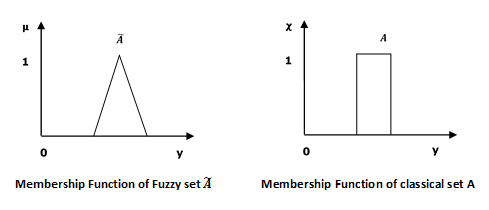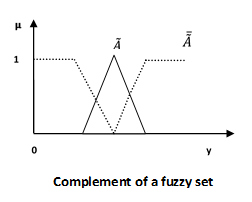
- Fuzzy Logic - Home
- Fuzzy Logic - Introduction
- Fuzzy Logic - Classical Set Theory
- Fuzzy Logic - Set Theory
- Fuzzy Logic - Membership Function
- Traditional Fuzzy Refresher
- Approximate Reasoning
- Fuzzy Logic - Inference System
- Fuzzy Logic - Database and Queries
- Fuzzy Logic - Quantification
- Fuzzy Logic - Decision Making
- Fuzzy Logic - Control System
- Adaptive Fuzzy Controller
- Fuzziness in Neural Networks
- Fuzzy Logic - Applications
Fuzzy Logic - Set Theory
Fuzzy sets can be considered as an extension and gross oversimplification of classical sets. It can be best understood in the context of set membership. Basically it allows partial membership which means that it contain elements that have varying degrees of membership in the set. From this, we can understand the difference between classical set and fuzzy set. Classical set contains elements that satisfy precise properties of membership while fuzzy set contains elements that satisfy imprecise properties of membership.

Mathematical Concept
A fuzzy set $\widetilde{A}$ in the universe of information $U$ can be defined as a set of ordered pairs and it can be represented mathematically as −
$$\widetilde{A} = \left \{ \left ( y,\mu _{\widetilde{A}} \left ( y \right ) \right ) | y\in U\right \}$$
Here $\mu _{\widetilde{A}}\left ( y \right )$ = degree of membership of $y$ in \widetilde{A}, assumes values in the range from 0 to 1, i.e., $\mu _{\widetilde{A}}(y)\in \left [ 0,1 \right ]$.
Representation of fuzzy set
Let us now consider two cases of universe of information and understand how a fuzzy set can be represented.
Case 1
When universe of information $U$ is discrete and finite −
$$\widetilde{A} = \left \{ \frac{\mu _{\widetilde{A}}\left ( y_1 \right )}{y_1} +\frac{\mu _{\widetilde{A}}\left ( y_2 \right )}{y_2} +\frac{\mu _{\widetilde{A}}\left ( y_3 \right )}{y_3} +...\right \}$$
$= \left \{ \sum_{i=1}^{n}\frac{\mu _{\widetilde{A}}\left ( y_i \right )}{y_i} \right \}$
Case 2
When universe of information $U$ is continuous and infinite −
$$\widetilde{A} = \left \{ \int \frac{\mu _{\widetilde{A}}\left ( y \right )}{y} \right \}$$
In the above representation, the summation symbol represents the collection of each element.
Operations on Fuzzy Sets
Having two fuzzy sets $\widetilde{A}$ and $\widetilde{B}$, the universe of information $U$ and an element of the universe, the following relations express the union, intersection and complement operation on fuzzy sets.
Union/Fuzzy OR
Let us consider the following representation to understand how the Union/Fuzzy OR relation works −
$$\mu _{{\widetilde{A}\cup \widetilde{B} }}\left ( y \right ) = \mu _{\widetilde{A}}\vee \mu _\widetilde{B} \quad \forall y \in U$$
Here ∨ represents the max operation.

Intersection/Fuzzy AND
Let us consider the following representation to understand how the Intersection/Fuzzy AND relation works −
$$\mu _{{\widetilde{A}\cap \widetilde{B} }}\left ( y \right ) = \mu _{\widetilde{A}}\wedge \mu _\widetilde{B} \quad \forall y \in U$$
Here ∧ represents the min operation.

Complement/Fuzzy NOT
Let us consider the following representation to understand how the Complement/Fuzzy NOT relation works −
$$\mu _{\widetilde{A}} = 1-\mu _{\widetilde{A}}\left ( y \right )\quad y \in U$$

Properties of Fuzzy Sets
Let us discuss the different properties of fuzzy sets.
Commutative Property
Having two fuzzy sets $\widetilde{A}$ and $\widetilde{B}$, this property states −
$$\widetilde{A}\cup \widetilde{B} = \widetilde{B}\cup \widetilde{A}$$
$$\widetilde{A}\cap \widetilde{B} = \widetilde{B}\cap \widetilde{A}$$
Associative Property
Having three fuzzy sets $\widetilde{A}$, $\widetilde{B}$ and $\widetilde{C}$, this property states −
$$(\widetilde{A}\cup \left \widetilde{B}) \cup \widetilde{C} \right = \left \widetilde{A} \cup (\widetilde{B}\right )\cup \widetilde{C})$$
$$(\widetilde{A}\cap \left \widetilde{B}) \cap \widetilde{C} \right = \left \widetilde{A} \cup (\widetilde{B}\right \cap \widetilde{C})$$
Distributive Property
Having three fuzzy sets $\widetilde{A}$, $\widetilde{B}$ and $\widetilde{C}$, this property states −
$$\widetilde{A}\cup \left ( \widetilde{B} \cap \widetilde{C}\right ) = \left ( \widetilde{A} \cup \widetilde{B}\right )\cap \left ( \widetilde{A}\cup \widetilde{C} \right )$$
$$\widetilde{A}\cap \left ( \widetilde{B}\cup \widetilde{C} \right ) = \left ( \widetilde{A} \cap \widetilde{B} \right )\cup \left ( \widetilde{A}\cap \widetilde{C} \right )$$
Idempotency Property
For any fuzzy set $\widetilde{A}$, this property states −
$$\widetilde{A}\cup \widetilde{A} = \widetilde{A}$$
$$\widetilde{A}\cap \widetilde{A} = \widetilde{A}$$
Identity Property
For fuzzy set $\widetilde{A}$ and universal set $U$, this property states −
$$\widetilde{A}\cup \varphi = \widetilde{A}$$
$$\widetilde{A}\cap U = \widetilde{A}$$
$$\widetilde{A}\cap \varphi = \varphi$$
$$\widetilde{A}\cup U = U$$
Transitive Property
Having three fuzzy sets $\widetilde{A}$, $\widetilde{B}$ and $\widetilde{C}$, this property states −
$$If \: \widetilde{A}\subseteq \widetilde{B}\subseteq \widetilde{C},\:then\:\widetilde{A}\subseteq \widetilde{C}$$
Involution Property
For any fuzzy set $\widetilde{A}$, this property states −
$$\overline{\overline{\widetilde{A}}} = \widetilde{A}$$
De Morgans Law
This law plays a crucial role in proving tautologies and contradiction. This law states −
$$\overline{{\widetilde{A}\cap \widetilde{B}}} = \overline{\widetilde{A}}\cup \overline{\widetilde{B}}$$
$$\overline{{\widetilde{A}\cup \widetilde{B}}} = \overline{\widetilde{A}}\cap \overline{\widetilde{B}}$$